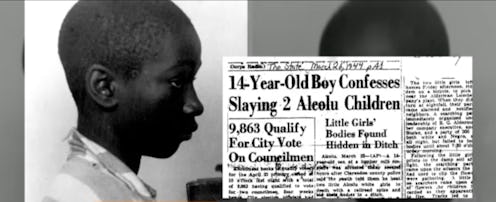News
The Youngest American Executed Wasn't Guilty

In 1944, a 14-year-old African-American boy was sent to the electric chair in the small, segregated mill town of Alcolu, South Carolina. Still two decades away from civil rights, Alcolu was a hostile, racially charged area where Jim Crow laws barred African-Americans from the right to vote and equal access to education and employment. According to historians, that climate of systemic racism made it easy, then, for an all-white jury to convict African-American teenager George Stinney Jr. of first-degree murder of two young white girls.
There was absolutely no evidence against Stinney, whose parents were forced out of town shortly after his arrest, leaving the 14-year-old with little support during his trial. According to accounts, there was a confession from Stinney, which many believe was made under coercion from authorities. Three months after he was arrested for the murders, the jury reportedly deliberated for just 10 minutes before handing down the guilty verdict.
But on Wednesday morning, 70 years later, Judge Carmen Mullins of the South Carolina Circuit Court exonerated Stinney, finally clearing the teenager's name. In her ruling vacating Stinney's murder conviction, Mullins said his right to due process was violated, because he was virtually denied a defense:
Given the particularized circumstances of Stinney's case, I find by a preponderance of the evidence standard, that a violation of the Defendant's procedural due process rights tainted his prosecution.
Mullins also found that sending a 14-year-old to the electric chair was cruel and unusual punishment. Stinney was the youngest person in U.S. history to receive the death penalty in the 20th century.
Mullins ruling comes almost a year after she heard arguments in the case, allowing lawyers on both sides to provide witnesses and evidence in a two-day hearing held last January. According to the Associated Press, the hearing was essentially Stinney's first true day in court, as Stinney's lawyer in 1944 called no witnesses to the stand, nor did he cross-examine any of the prosecution's witnesses. By all accounts, Stinney did not have a fair or just trial.
Stinney's second cousin Irene Hill, who attended his hearing, told the AP in January:
I'm glad he got his day in court. But what good can it do him now? We can't bring him back, but we can restore his name.
Stinney's sister Amie Ruffner, who was with him the day of the murder and provided an alibi for her brother, recently recounted to CNN affiliate WLTX what happened that day in 1944. The two white girls rode up to them near the railroad tracks, Ruffner said, and asked about where they could find a type of flower. The brother and sister never saw the two girls again. "[The police] were looking for someone to blame it on, so they used my brother as a scapegoat," Ruffner told the news source.Although she had an alibi for her accused brother, Ruffner was never invited to testify in court.
In an amicus brief filed earlier in 2014, the Civil Rights and Restorative Justice Project of the Northeastern University School of Law called Stinney's trial and death penalty conviction a "grave miscarriage of justice," and that the teenager's "shocking treatment was inconsistent with the most fundamental notions of due process."
Lawyers for the CRRJ continued:
There is compelling evidence that George Stinney was innocent of the crimes for which he was executed in 1944. The prosecutor relied, almost exclusively, on one piece of evidence to obtain a conviction in this capital case: the unrecorded, unsigned “confession” of a 14-year-old child who was deprived of counsel and parental guidance, and whose defense lawyer shockingly failed to call exculpating witnesses or to preserve his right of appeal.
Images: Getty Images (3)